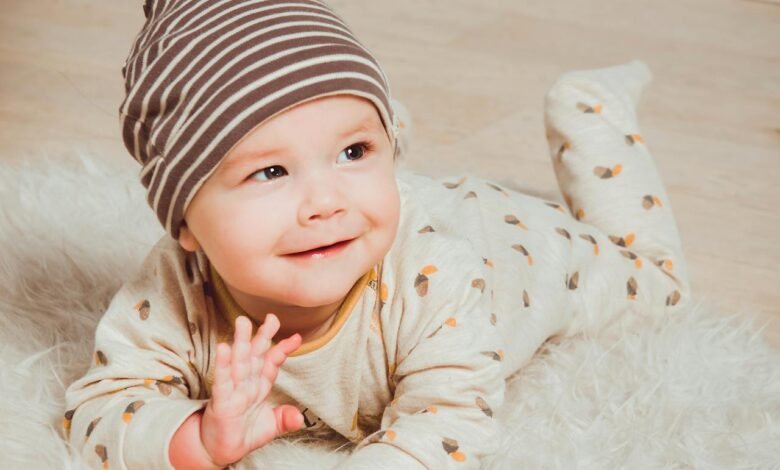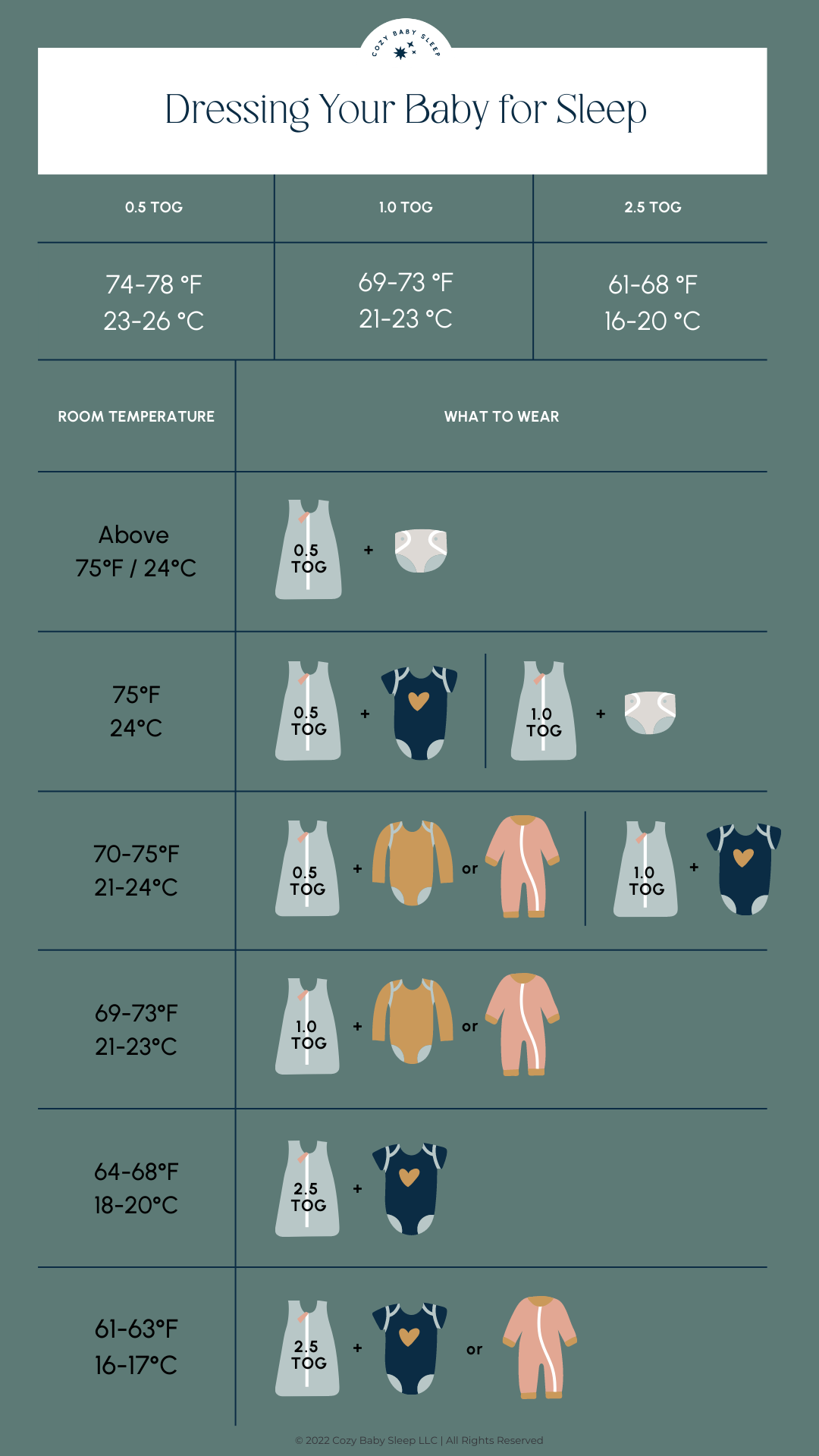How to Dress Baby for Sleep: Cozy & Safe Nightwear Tips

Choose comfortable and breathable clothing suitable for the temperature and consider using a sleep sack or swaddle for added warmth and security. Getting your baby dressed for sleep requires careful consideration of their comfort and safety.
It is important to choose clothing that is appropriate for the temperature and allows their skin to breathe. Opt for soft, comfortable fabrics that won’t irritate their delicate skin. Consider using a sleep sack or swaddle to keep them warm and secure throughout the night.
Remember to avoid any loose clothing or items that could pose a suffocation risk. By following these guidelines, you can ensure that your baby is dressed appropriately for a good night’s sleep.
The Basics Of Baby Sleepwear
Baby sleepwear plays a crucial role in ensuring your little one stays comfortable and safe throughout the night. From fabric choices to fit and comfort, selecting the right sleepwear is essential for promoting restful sleep. Let’s explore the key factors to consider when dressing your baby for sleep.
Fabric Choices
- Cotton is ideal for baby sleepwear due to its breathable and soft properties.
- Avoid synthetic fabrics that can cause irritation and discomfort.
- Opt for organic cotton to minimize exposure to harsh chemicals.
Fit And Comfort
- Choose sleepwear that is loose and allows for easy movement.
- Avoid items with tight elastics or restrictive features.
- Ensure the sleepwear fastenings are secure to prevent any choking hazards.
Seasonal Dressing Guide
How to dress baby for sleep? It’s important to consider the season. As the temperature changes, so should your baby’s sleepwear. In this seasonal dressing guide, we’ll take a closer look at how to dress your baby for sleep in the summer and winter months.
Summer Sleepwear
During the summer, it’s important to dress your baby in lightweight, breathable fabrics to keep them cool and comfortable. Opt for cotton or bamboo sleepwear that’s loose-fitting and not too tight. If your baby is still swaddled, consider switching to a lightweight muslin wrap that’s airy and breathable.
- Choose light-colored sleepwear to reflect the sun’s rays and keep your baby cool.
- Avoid dressing your baby in too many layers.
- Consider using a fan or air conditioning to keep the room cool.
Winter Warmth
When the temperature drops, it’s important to dress your baby in warm, cozy sleepwear to help them stay comfortable and sleep soundly. Opt for sleepwear made from soft, warm materials such as fleece or flannel. You can also use a sleep sack or wearable blanket to keep your baby warm without the need for loose blankets.
- Dress your baby in layers to regulate their body temperature.
- Choose sleepwear that fits snugly without being too tight.
- Avoid using loose blankets or bedding in the crib.
By following these seasonal dressing tips, you can help ensure that your baby is comfortable and safe while sleeping, no matter what the temperature is outside.
Safety First: Avoiding Hazards
Keep your baby safe during sleep by dressing them in breathable fabrics to prevent overheating. Opt for a sleep sack instead of loose blankets to reduce the risk of suffocation. Remember, safety comes first when it comes to dressing your little one for bedtime.
Dressing your baby for sleep can be a daunting task, especially for new parents. While it is important to keep your baby warm and cozy, it is even more important to prioritize their safety. In this article, we will discuss some safety tips to keep in mind while dressing your baby for sleep.
Loose Items
Loose items in your baby’s sleep environment can pose a serious hazard. Avoid dressing your baby in clothing with loose buttons, strings, or ties that could come undone and become a choking hazard. Additionally, avoid using blankets, pillows, or stuffed animals in your baby’s crib as these items can increase the risk of suffocation or Sudden Infant Death Syndrome (SIDS). Instead, opt for a sleep sack or a wearable blanket that fits snugly around your baby.
Flame Resistance
It is important to ensure that your baby’s sleepwear is flame-resistant. This is especially important if you use a space heater or have any other potential fire hazards in your baby’s sleep environment. Look for sleepwear that is labeled as “flame-resistant” or “fire-retardant.” In conclusion, keeping your baby safe while they sleep should always be a top priority. By following these simple safety tips, you can help reduce the risk of accidents and ensure that your baby sleeps soundly and comfortably.
Layering For Comfort
To ensure your baby sleeps comfortably, consider layering their clothing for optimal warmth without overheating. Start with a soft onesie, add a cozy sleep sack or swaddle, and top it off with a breathable blanket for a peaceful night’s rest.
When it comes to dressing your baby for sleep, layering is key to ensuring their comfort throughout the night. Layering allows you to adjust their clothing based on the room temperature and their individual needs. By following a few simple guidelines, you can create the perfect sleep environment for your little one.
How Many Layers?
When determining how many layers to dress your baby in for sleep, it’s important to consider their age, the season, and the temperature of the room. As a general rule, infants under 12 months old typically need one additional layer than adults. For example, if you’re comfortable in a short-sleeved shirt, your baby may need a long-sleeved onesie or a light sleep sack.
Below is a table to help you determine the appropriate number of layers based on room temperature:
| Room Temperature | Number of Layers |
|---|---|
| 75°F (24°C) and above | One layer (e.g., a light onesie) |
| 68-74°F (20-23°C) | Two layers (e.g., a onesie and a light sleep sack) |
| 64-67°F (18-19°C) | Three layers (e.g., a onesie, a sleeper, and a sleep sack) |
| Below 64°F (18°C) | Four or more layers (e.g., a onesie, sleeper, sleep sack, and a light blanket) |
Adjusting For Room Temperature
Room temperature plays a crucial role in determining how many layers your baby needs for sleep. It’s important to regularly monitor the temperature of the room and adjust their clothing accordingly. Keep in mind that babies can easily overheat, so it’s better to err on the side of dressing them too lightly rather than too warmly.
If the room feels too warm, consider removing a layer or opting for lighter fabrics. On the other hand, if the room feels too cool, add an extra layer or choose thicker materials to keep your baby cozy and comfortable throughout the night.
By layering your baby’s clothing appropriately and adjusting for room temperature, you can ensure they are comfortable and safe during sleep. Remember to regularly check their clothing and the room temperature to maintain a comfortable sleep environment for your little one.
Accessorizing For Sleep
Ensure a restful night’s sleep for your baby by dressing them appropriately. Discover helpful tips and tricks for accessorizing their sleepwear to promote comfort and safety throughout the night.
Babies can be sensitive to temperature changes while sleeping, so it’s important to dress them appropriately for a comfortable and safe night’s rest. Accessorizing for sleep involves choosing the right items that can help regulate their body temperature and provide a cozy sleeping environment. Let’s explore the essentials for dressing your baby for sleep, including hats and socks, sleep sacks, and swaddles.
Hats And Socks: Yes Or No?
When it comes to accessorizing your baby for sleep, hats and socks can be beneficial in colder environments. However, it’s important to ensure that they are not too tight or restrictive, as this can affect your baby’s circulation. Opt for soft, breathable materials to avoid overheating, and always check that the hat or socks don’t pose a suffocation risk. If the room is comfortably warm, skipping the hat and socks is perfectly fine.
Sleep Sacks And Swaddles
Sleep sacks and swaddles are excellent accessories for promoting safe and sound sleep for your baby. These items provide a snug and secure feeling, mimicking the cozy environment of the womb. Sleep sacks are particularly useful for keeping your baby warm without the hazard of loose blankets. Swaddles can help soothe babies and prevent the startle reflex, promoting longer and more restful sleep.

Credit: www.reddit.com
Special Considerations
When it comes to dressing your baby for sleep, there are a few special considerations to keep in mind. Babies have delicate skin and are more prone to certain conditions, such as eczema and sensitive skin. Additionally, choosing organic materials can provide added benefits for your little one’s comfort and overall well-being.
Eczema And Sensitive Skin
Babies with eczema or sensitive skin require extra care when it comes to their sleepwear. It’s important to choose clothing that is gentle on their skin and minimizes irritation. Look for fabrics that are soft, breathable, and hypoallergenic. Avoid rough materials or those with synthetic fibers that can cause discomfort or trigger flare-ups.
Consider using natural fabrics like organic cotton or bamboo, as these materials are known for their softness and ability to wick away moisture. These fabrics are less likely to cause irritation and can help keep your baby’s skin cool and dry throughout the night.
Choosing Organic Materials
Opting for organic materials when dressing your baby for sleep can provide added benefits in terms of both comfort and health. Organic fabrics are made without the use of harmful chemicals, pesticides, or synthetic dyes, making them a safer choice for your little one’s delicate skin.
Organic cotton, for example, is grown without the use of synthetic fertilizers or pesticides, reducing the risk of exposure to potentially harmful substances. This can be particularly important for babies with sensitive skin or those prone to allergies. By choosing organic sleepwear, you can minimize the risk of skin irritation and create a healthier sleep environment for your baby.
When dressing your baby for sleep, it’s important to consider any specific needs they may have, such as eczema or sensitive skin. Opting for organic materials can also provide added benefits in terms of comfort and overall health. By paying attention to these special considerations, you can ensure that your baby is dressed appropriately for a good night’s sleep.
Laundry Tips For Baby Sleepwear
Babies spend a significant amount of time sleeping, making it crucial to ensure their sleepwear is clean, soft, and comfortable. Proper laundering of baby sleepwear is essential to maintain hygiene and prevent skin irritation.
Detergents And Baby’s Skin
Choosing gentle, fragrance-free detergents is vital to prevent skin irritation in babies.
Maintaining Fabric Integrity
To maintain fabric integrity, wash sleepwear inside out to preserve fabric quality.

Credit: babylovessleep.com.au
Making Night Changes Easier
Preparing your baby for sleep can be made easier by dressing them in comfortable, breathable sleepwear. Opt for soft, cozy fabrics to keep them snug and ensure a peaceful night’s sleep. Avoid overdressing to prevent overheating and promote better rest.
Sleepwear With Easy Access
Choose pajamas with simple snaps or zippers for effortless diaper changes at night.
Keeping The Sleep Environment
Ensure the room is dark, quiet, and comfortably cool to promote restful sleep.
When dressing your baby for sleep, opt for practical clothing choices that simplify the nighttime routine.
Sleepwear With Easy Access
Avoid complicated outfits that make diaper changes challenging during the night.
Keeping The Sleep Environment
Maintain a soothing atmosphere in the nursery to encourage uninterrupted sleep.

Credit: www.cozybabysleep.com
Frequently Asked Questions
How Should I Dress My Baby For Sleep?
To dress your baby for sleep, use a light, breathable sleeper or onesie to prevent overheating. Consider the room temperature and add a wearable blanket if needed. Avoid overdressing your baby and ensure that the clothing is comfortable and safe for sleeping.
What Fabric Is Best For Baby Sleepwear?
Opt for sleepwear made from natural, breathable fabrics such as cotton or bamboo. These materials are gentle on the baby’s skin and help regulate body temperature, reducing the risk of overheating during sleep. Avoid synthetic fabrics that can trap heat and moisture.
Can A Baby Sleep With A Blanket?
It’s safest to avoid using loose blankets in the crib for babies under one year old. Instead, consider using a wearable blanket or sleep sack to keep the baby warm without the risk of suffocation. Once the baby is older, a small, lightweight blanket can be introduced.
Always prioritize safety in the crib.
Conclusion
Dressing your baby for sleep is a crucial aspect of ensuring their safety and comfort. By choosing the right clothing and creating a suitable sleep environment, you can promote better sleep for your little one. Remember to prioritize breathability, comfort, and safety when selecting sleepwear for your baby.





